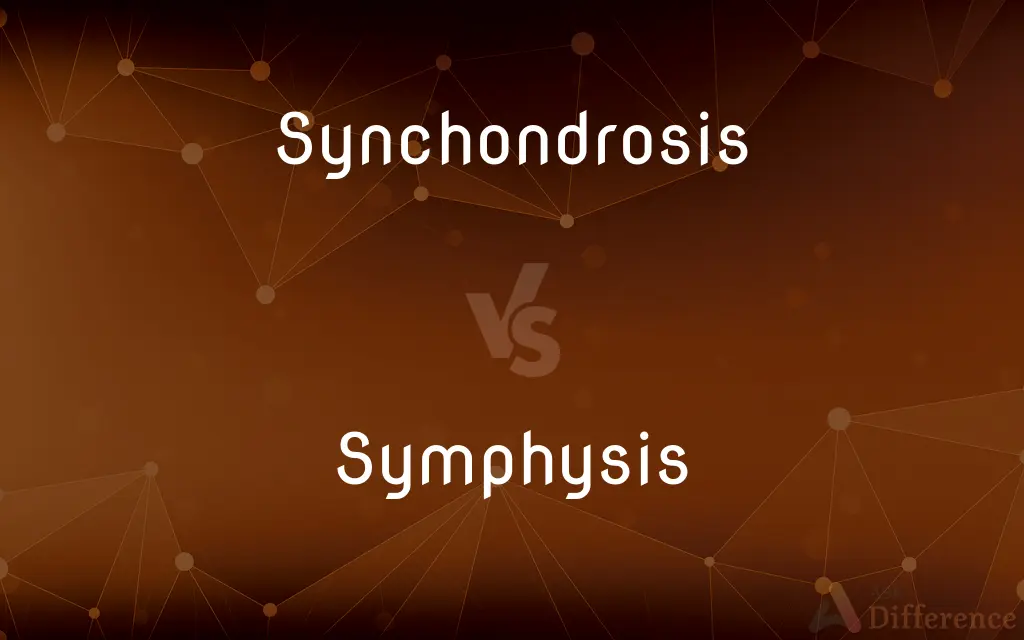Synchondrosis vs. Symphysis — What's the Difference?
By Urooj Arif & Maham Liaqat — Updated on March 25, 2024
Synchondrosis involves cartilage connecting bones and is typically temporary, present in growing individuals, while symphysis involves fibrocartilage connecting bones, is permanent, and allows for slight movement.

Difference Between Synchondrosis and Symphysis
Table of Contents
ADVERTISEMENT
Key Differences
Synchondrosis is a type of joint where bones are joined by hyaline cartilage, often found in growing parts of the body, such as the growth plates of long bones. These joints are temporary and eventually ossify (turn into bone) as growth ceases. Symphysis, on the other hand, refers to a joint where bones are connected by a pad of fibrocartilage. This type of joint is permanent and provides strength, shock absorption, and a limited degree of movement, such as in the pubic symphysis and intervertebral discs.
The primary function of synchondrosis is to enable bone growth, allowing for the elongation of bones during development. This is crucial for the overall growth of the skeleton. In contrast, the symphysis serves to absorb shock, permit slight mobility, and maintain the integrity of the pelvic girdle and vertebral column, supporting the body's weight and allowing for various movements.
Synchondrosis joints are characterized by their rigidity and lack of movement, providing a stable structure necessary for the growth phases of the skeleton. Once growth is completed, these joints typically ossify and become immovable. Symphyses, however, allow for a slight degree of flexibility and movement, which is essential for functions such as childbirth, where the pubic symphysis slightly widens to facilitate delivery.
The location of synchondrosis joints is typically found in areas of the body undergoing growth, such as between the shaft and the end of long bones, or between the ribs and sternum in young individuals. Symphysis joints are found in the midline of the body, notably in the vertebral column between intervertebral discs and at the pubic symphysis in the pelvis.
Due to their temporary nature, synchondrosis joints do not usually present with clinical issues related to movement or degeneration, as they are replaced by bone over time. Symphysis joints, however, can be sites of pain and degeneration, particularly in conditions like osteoarthritis or during pregnancy when the pubic symphysis may become overly flexible or unstable.
ADVERTISEMENT
Comparison Chart
Cartilage Type
Hyaline cartilage
Fibrocartilage
Temporality
Temporary, ossifies over time
Permanent
Movement
Generally immovable
Allows slight movement
Function
Enables bone growth
Absorbs shock, permits flexibility
Common Locations
Growth plates, costochondral joints
Pubic symphysis, intervertebral discs
Compare with Definitions
Synchondrosis
Crucial for the elongation and development of bones.
Synchondrosis allows for the lengthening of the femur during childhood.
Symphysis
Acts as a shock absorber in the skeletal system.
The fibrocartilage in the pubic symphysis absorbs impacts during walking.
Synchondrosis
Connects bones via hyaline cartilage.
The first rib's articulation with the sternum is a synchondrosis.
Symphysis
Can be a site of pain or osteoarthritis.
Degeneration of intervertebral discs can lead to back pain and mobility issues.
Synchondrosis
A classic example of synchondrosis, facilitating bone growth.
Growth plates in the knee ossify after puberty, ending growth.
Symphysis
Remains throughout life, allowing for slight flexibility.
Intervertebral discs are symphyses that provide spinal flexibility.
Synchondrosis
Provides stability and support, with no movement.
Synchondrosis joints in the skull base are rigid to protect the brain.
Symphysis
Enables limited movement between bones.
The symphysis allows for the expansion of the pelvis during childbirth.
Synchondrosis
Typically ossifies after a period, becoming bone.
The epiphyseal plate in long bones is a synchondrosis during growth.
Symphysis
Bones are joined by a pad of fibrocartilage.
The pubic symphysis cushions and supports the pelvis.
Synchondrosis
A synchondrosis (or primary cartilaginous joint) is a type of cartilaginous joint where hyaline cartilage completely joins together two bones. Synchondroses are different than symphyses (secondary cartilaginous joints) which are formed of fibrocartilage.
Symphysis
A symphysis is a fibrocartilaginous fusion between two bones. It is a type of cartilaginous joint, specifically a secondary cartilaginous joint.
Synchondrosis
A form of articulation in which the bones are rigidly fused by cartilage.
Symphysis
A growing together of bones originally separate, as of the two pubic bones or the two halves of the lower jawbone.
Synchondrosis
(skeleton) A form of only slightly-moveable articulation between bones joined by hyaline cartilage, as in the spinal vertebrae.
Symphysis
A line or junction thus formed.
Synchondrosis
An immovable articulation in which the union is formed by cartilage.
Symphysis
An articulation in which bones are united by cartilage without a synovial membrane.
Symphysis
The coalescence of similar parts or organs.
Symphysis
(skeleton) The process of two originally separate bones growing together as the subject matures, as with the pubic bones or lower jawbones in humans.
Symphysis
(skeleton) A place where two bones are closely joined in the median plane of the body, either forming an immovable joint (as between the pubic bones in the center of the pelvis) or completely fused (as at the midline of the lower jaw).
Symphysis
(medicine) A line, discernable on an X-ray, showing such fusion.
Symphysis
(skeleton) The cartilaginous material that adjoins and facilitates the junction of such bones, without a synovial membrane.
Symphysis
An articulation formed by intervening cartilage; as, the pubic symphysis.
Symphysis
An abnormal adhesion of two or more structures
Symphysis
A growing together of parts or structures
Common Curiosities
Why is symphysis important in the pelvis?
It provides flexibility and shock absorption, crucial for supporting body weight, movement, and childbirth.
How does the function of symphysis contribute to spinal health?
Intervertebral symphysis discs allow for flexibility and act as shock absorbers, reducing stress on the spinal column.
What distinguishes synchondrosis from symphysis?
Synchondrosis involves temporary hyaline cartilage joints for growth, while symphysis involves permanent fibrocartilage joints for slight movement and shock absorption.
Do synchondrosis joints move?
Generally, they are immovable and provide stability during growth phases until they ossify into bone.
Can conditions affecting symphysis be treated?
Yes, treatments may include physical therapy, pain management, and sometimes surgery for severe cases of degeneration or instability.
Can synchondrosis become a symphysis?
No, synchondrosis typically ossifies into bone, whereas symphysis remains as a fibrocartilage joint throughout life.
What happens to synchondrosis after growth stops?
It ossifies and becomes part of the bone, losing its cartilage structure and becoming immovable.
How does aging affect symphysis joints?
Aging can lead to the wear and tear of symphysis joints, potentially resulting in pain, stiffness, and reduced mobility.
Is the presence of synchondrosis indicative of ongoing growth?
Yes, the presence of synchondrosis, such as growth plates, indicates areas of the body where growth is occurring.
Why are synchondrosis joints not a common site of arthritis?
Since they ossify into bone and do not allow for movement, they are not prone to the wear and tear that typically leads to arthritis.
Share Your Discovery

Previous Comparison
Simple vs. Easy
Next Comparison
Sparrow vs. SwallowAuthor Spotlight
Written by
Urooj ArifUrooj is a skilled content writer at Ask Difference, known for her exceptional ability to simplify complex topics into engaging and informative content. With a passion for research and a flair for clear, concise writing, she consistently delivers articles that resonate with our diverse audience.
Co-written by
Maham Liaqat















































